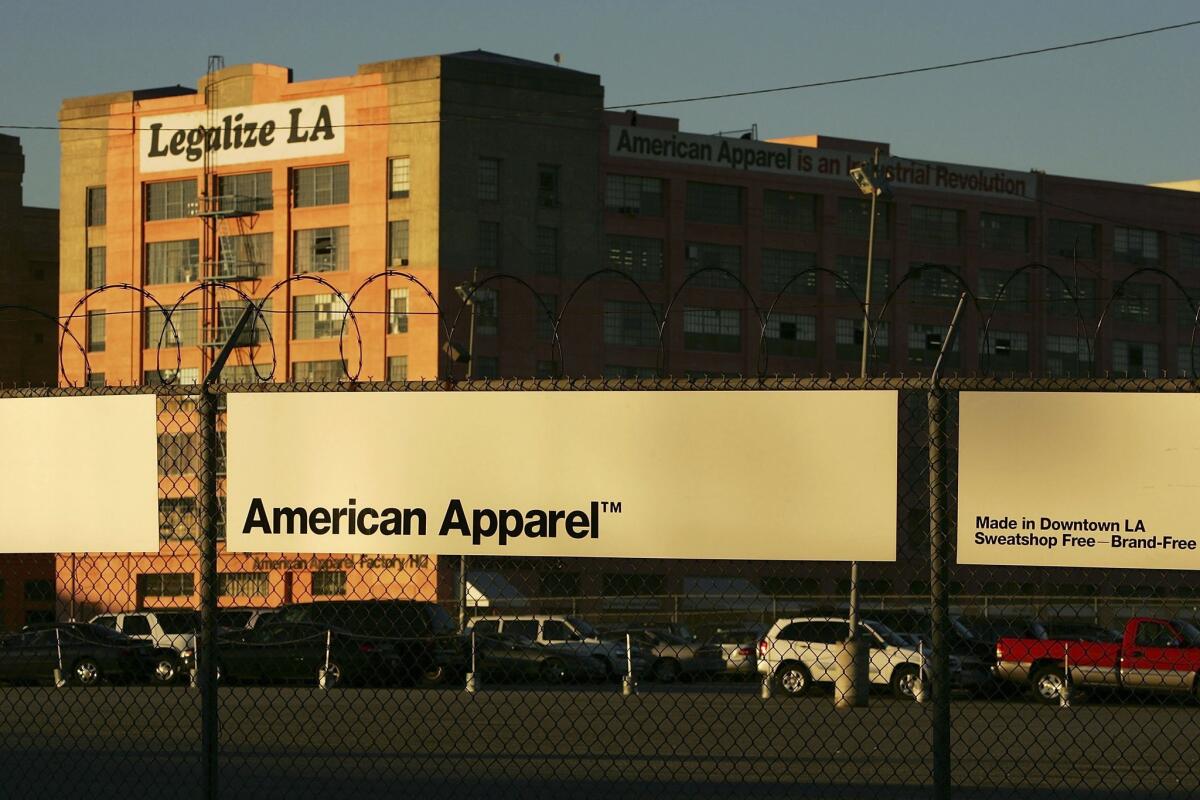American Apparel to close underperforming stores, lay off workers

American Apparel said Monday it plans to close some stores and lay off workers.
- Share via
Struggling Los Angeles clothier American Apparel Inc. is laying off workers and closing some stores as part of an ongoing effort to turn around its tumultuous business.
The Los Angeles clothing maker would not disclose the number of stores or jobs that will be cut. It also did not say whether the layoffs, which will begin immediately, will affect its manufacturing workers, its retail employees or both. But a source close to the company said most of the layoffs would affect jobs at corporate headquarters and at stores.
The company employs about 10,000 workers worldwide, with about 4,600 manufacturing and office workers based in Southern California. The initiatives will save about $30 million over the next year and a half, the company said.
American Apparel “will streamline its workforce to reflect a smaller store footprint and general industry conditions,” American Apparel said in a statement Monday.
Chief Executive Paula Schneider said in the statement that the changes are “necessary steps” to “preserve jobs for the overwhelming majority” of employees.
It is the second cutback this year. In April, American Apparel laid off about 180 employees, mostly in its sprawling manufacturing operations in the Southland.
American Apparel workers, who have already dealt this year with layoffs, furloughs and reduced hours, say they are scared and frustrated.
“The majority of people — we are very fearful that any minute it will hit any of us,” said Piedad Torres, 59, a seamstress who has worked at American Apparel for two years.
The downtown Los Angeles resident said fellow factory workers have lost faith in management, which often sends them letters proclaiming that “everything is fine financially and everything is improving.”
“But the reality,” Torres said, “is very different.” A year ago, she said she could earn $400 or more a week. But with lower production and fewer hours, Torres said she often earns only half as much — not enough to support herself and her son, who is a college student.
Unhappy employees have held numerous protests and meetings over the last few months around Los Angeles, including at corporate headquarters in downtown Los Angeles.
More than 2,500 workers have also signed cards granting Hermandad Mexicana, a local group that advocates for immigrant worker rights, permission to represent them in negotiating for better hours, said Nativo Lopez, a senior advisor with the group. Hermandad Mexicana is also helping workers begin the laborious process to unionize.
“They’re mad because they feel they have been deceived these last six months with multiple letters by management saying one thing, when the real situation is quite different,” Lopez said. The average manufacturing employee is now earning 50% of what she was a year ago, he said.
Despite its cost-cutting measures, American Apparel may continue to struggle.
In statements filed Monday with the Securities and Exchange Commission, the company said it may still be forced to raise additional capital to fund the business in the next year. But, the company warned, it may also be unable to raise that additional capital.
Analysts said American Apparel would have to undertake many more changes to turn around years of slipping sales and heavy debt.
“This is just the tip of the iceberg,” said Lloyd Greif, chief executive of Los Angeles investment banking firm Greif & Co. “This by itself isn’t going to fix anything. The patient is still on life support.”
To slash costs significantly, American Apparel will have to close 20 to 30 stores, bringing its store count closer to 200 from about 240, said Craig Johnson, president of Customer Growth Partners.
“It’s tough and necessary medicine,” he said. “A lot of store closures should come from the U.S., where a lot of the underperforming stores are.”
American Apparel has faced a rough ride after its board fired founder Dov Charney as chief executive and chairman last year, alleging misconduct.
The company said it is fending off about 20 lawsuits and other legal actions
filed by Charney and his allies.
Charney, who continues to vigorously pursue ways to reclaim the company, has filed lawsuits against American Apparel and Standard General, the hedge fund that threw the retailer a financial lifeline but failed to back his return to the company.
Charney has also filed an arbitration claim for wrongful termination. Two separate shareholder lawsuits also accuse American Apparel of engaging in proxy fraud related to Charney’s firing.
Last month, American Apparel fired back by releasing a wealth of lurid details about his alleged inappropriate behavior as part of a motion to try to halt his lawsuits. According to the filing, Charney allegedly referred to employees using racist slurs and stored footage on company equipment of himself having sex with models and employees. On Monday, American Apparel said it planned to “vigorously defend” itself against the lawsuits, which it deemed “meritless.”
The onslaught of litigation not only diverts money and attention away from saving the company, industry experts said, but also scares off potential investors.
Charney “is a guy who doesn’t let go,” Greif said. But “it’s not a recipe for taking the company back, it’s a recipe for taking the company down.”
American Apparel said it is determined to turn around its business.
In June, the company outlined a plan that included toning down the overt sexiness that has defined its advertising. The clothing maker, which posted $609 million in revenue last year and had 242 stores at the end of 2014, said it hoped to evolve into a business with $1 billion in annual sales.
The company also said Monday that it would debut a new fall line, part of its efforts to rejuvenate its apparel offerings. A successful fall lineup could signal a turn of fortunes for the retailer, while a flop could push the company toward bankruptcy, analysts said.
“The great unknown is the fall merchandise launch,” said Johnson of Customer Growth Partners.
“Is this going to be a continuation of American Apparel’s sort of basic, clean, colorful lines?” he said. “Or does it mark a new direction where they refocus the brand from a merchandise point of view? If so, what is that and who is that customer?”
Industry watchers said American Apparel may be forced to move its production offshore, especially after the minimum wage hike in Los Angeles boosts hourly pay to $15 by 2020. Company executives have repeatedly vowed that manufacturing will continue to be based in the U.S.
If American Apparel starts offshoring work, that will spell even more lost
jobs.
“To make a change like that, you will have more significant layoffs,” Greif said. “You don’t need those bodies.”
Follow Shan Li on Twitter @ShanLi
More to Read
Inside the business of entertainment
The Wide Shot brings you news, analysis and insights on everything from streaming wars to production — and what it all means for the future.
You may occasionally receive promotional content from the Los Angeles Times.











